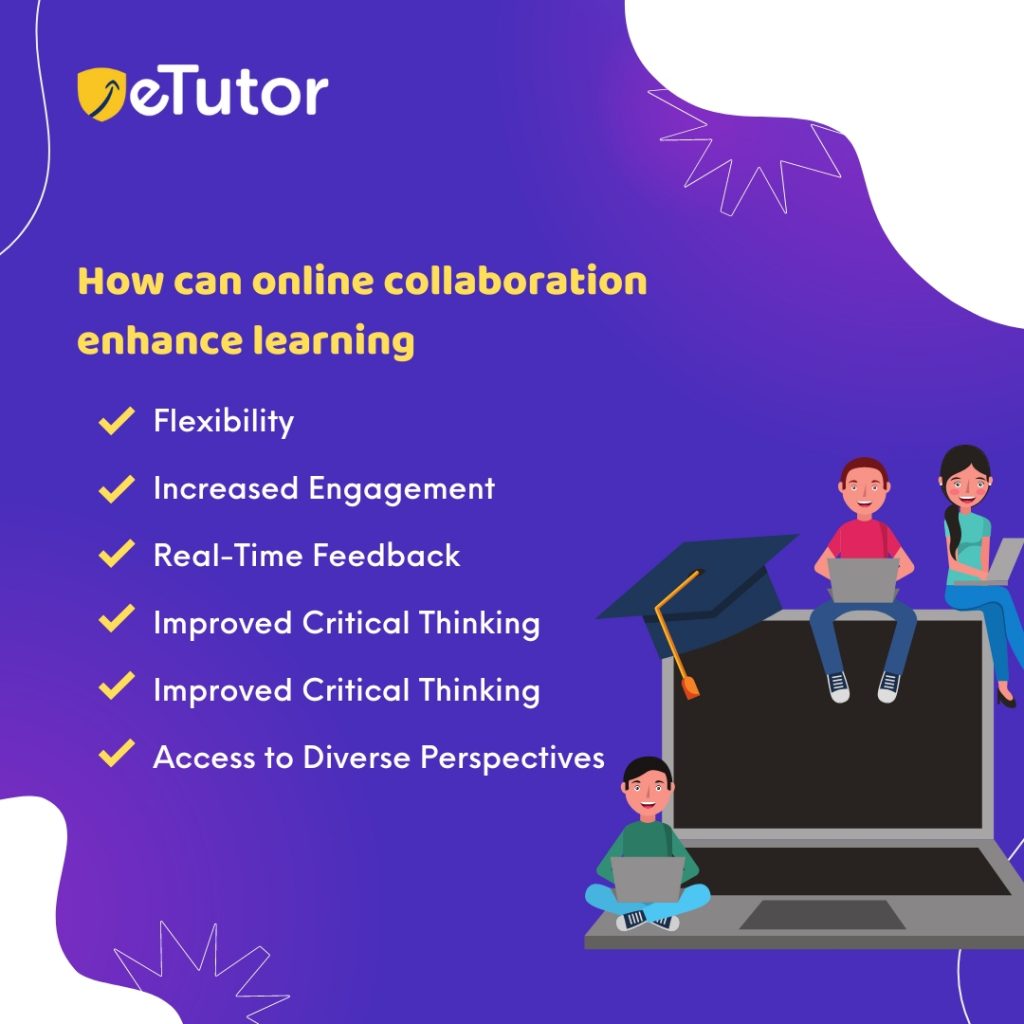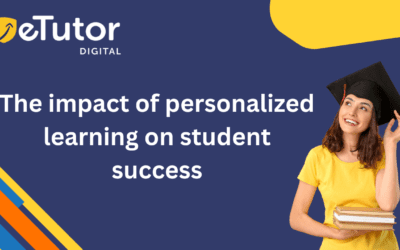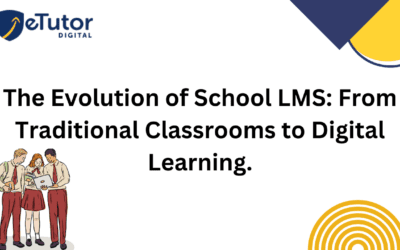How to Incorporate Collaborative Learning in the Classroom- Etutor

Table of contents
What is a collaborative learning
How can online collaboration enhance learning
What are the benefits of collaborative learning
Why is collaborative learning important
How does collaborative learning help students
How does collaborative learning motivate students
How to use collaborative learning in education
Conclusion
Frequently Asked Questions
What is collaborative learning?
Collaborative learning is an approach to education in which students work together in groups or pairs to solve problems, complete assignments, or discuss ideas. In a collaborative learning environment, students are encouraged to share their knowledge, skills, and experiences and to work together to achieve a common goal.
How can online collaboration enhance learning?

There are many ways that online collaboration can improve learning, including:
Flexibility: Since students can collaborate online regardless of where they are physically located, it can increase flexibility and accessibility for students with schedule or mobility issues.
Increased Engagement: Online collaboration can boost student engagement by enabling students to connect with their peers virtually. It is especially beneficial for students who might be shy or unwilling to participate in traditional classroom settings.
Real-Time Feedback: Online collaboration tools that provide real-time feedback and conversation, like discussion forums or chat rooms, can promote deeper learning and understanding of complicated subjects.
Improved Critical Thinking: Online collaboration forces students to consider their ideas critically and those of their peers, enhancing their necessary thinking abilities and encouraging higher-order thinking.
Enhanced Communication: Students’ written communication abilities can be improved by using online collaboration tools, which force them to write clearly.
Access to Diverse Perspectives: Online collaboration can allow students to hear different points of view and ideas from a broader range of peers, which can help students better comprehend complicated issues and foster an inclusive learning environment.
What are the benefits of collaborative learning?

Collaborative learning has several benefits, including:
Improved Learning: Collaborative learning can improve learning outcomes by allowing students to actively learn, practice their problem-solving skills, and receive feedback from their peers.
Increased Engagement: Collaborative learning can increase student engagement by making learning more interactive and social and allowing students to work together to achieve a common goal.
Enhanced Communication Skills: Collaborative learning can improve students’ communication skills by requiring them to articulate their ideas and listen to their peers’ perspectives.
Promotion of Diversity and Inclusivity: Collaborative learning can promote diversity and inclusivity by allowing students from different backgrounds to work together and learn from one another.
Development of Teamwork and Leadership Skills: Collaborative learning can develop students’ teamwork and leadership skills by requiring them to work together effectively and take on different roles within the group.
Examples of collaborative learning activities include group projects, peer review sessions, classroom discussions, and problem-based learning activities. Cooperative learning can be implemented in various educational settings, from elementary school classrooms to university lecture halls.
Why is collaborative learning important?

Collaborative learning is crucial because it encourages a more active and exciting learning environment, aids in developing vital social and communication skills, and can enhance academic results.
The following justifies the significance of collaborative learning:
Promotes Active Learning: For collaborative learning to be effective, students must actively participate in conversations, problem-solving activities, and peer review. The course material and concepts may be better understood due to this active participation.
Enhances Social and Communication Skills: Collaborative learning aids in the development of crucial social and communication abilities, including leadership, dispute resolution, and teamwork. Success in both academic and professional environments depends on these abilities.
Encourages Diverse viewpoints: Through collaborative learning, students can learn from one another and gain from the experiences and perspectives of others. Students’ exposure to many points of view can aid in developing their critical thinking abilities and broaden their comprehension of difficult situations.
Enhances Learning Outcomes: Research has demonstrated that collaborative learning enhances learning outcomes, including improved problem-solving abilities, increased memory of course information, and higher academic accomplishment.
Better Workforce Preparation: Teamwork and collaboration are crucial abilities for many occupations. Students who participate in collaborative learning have the chance to practice and refine these abilities, which can help them prepare for workplace success.
How does collaborative learning motivate students?
Students can be motivated by collaborative learning in a variety of ways, including:
Increased Engagement: Learning can become more interactive and social through collaborative methods, which can motivate and engage students more. Students are more inclined to participate in class discussions and activities when they believe their peers value their opinions.
Sense of Belonging: Students’ senses of community and belonging can be facilitated via collaborative learning. When students collaborate in groups, they have a sense of belonging to a team working towards a common objective, which may increase their enthusiasm and dedication to the task.
Personalization: By allowing students to collaborate on projects and activities relevant to their interests and areas of strength, collaborative learning enables students to tailor their educational experiences. Their desire to study and perform well may grow due to this.
Positive peer pressure: Collaborative learning can provide positive peer pressure that encourages students to put in more effort and deliver better work. Students are more likely to feel inspired to work hard and succeed when they observe their peers doing so.
Immediate Feedback: Collaborative learning gives students access to immediate feedback, which can be inspiring. Students can modify their approach and enhance their work based on their peers’ comments in real-time.
Sense of Achievement: Students who participate in collaborative learning may feel a sense of achievement. Students gain pleasure and satisfaction from their work when they collaborate to finish a project or solve a problem, inspiring them to keep studying and collaborating.
How to use collaborative learning in education
Here are some examples of how collaborative learning can be used in the classroom:
Group Projects: Assign pupils a project or assignment they must do in groups. It enables students to collaborate and share ideas, abilities, and resources to accomplish a common objective.
Peer review: Request that students evaluate and comment on each other’s work. It not only gives students a chance to get peer input but also fosters the development of their communication and critical thinking abilities.
Encourage students to participate in class discussions where they can express their thoughts and opinions on a particular subject. Students can learn from one another while encouraging critical thinking and active interaction.
Jigsaw Technique: Assign each group of pupils a particular aspect of a subject or idea to research and present to the class. Students can teach and learn from one another, promoting active learning.
Peer tutoring: Assign students with various skill levels to work in pairs. The less experienced student can benefit from the more experienced student’s assistance and advice, which can boost their self-esteem and deepen their comprehension of the subject.
Collaborative learning: Collaborative learning can be facilitated online via chat rooms, discussion boards, and video conferencing. Students can collaborate in this way regardless of where they are physically located.
Conclusion:
In an array of educational environments, collaborative learning has the potential to be a highly successful means of fostering understanding and student engagement. It is crucial to remember that the activity’s design, the group’s dynamics, and the individual learners’ aptitude and drive all have a role in how well collaborative learning goes.
Educators should carefully plan and develop collaborative activities that align with learning objectives, lay out explicit norms and expectations, and include opportunities for reflection and feedback to maximize the advantages of collaborative learning. Teachers should also create a welcoming climate in the classroom that promotes involvement, honest communication, and constructive criticism.
Frequently Asked Questions
Author: Saritha Reddy
Website: https://www.etutor.co







